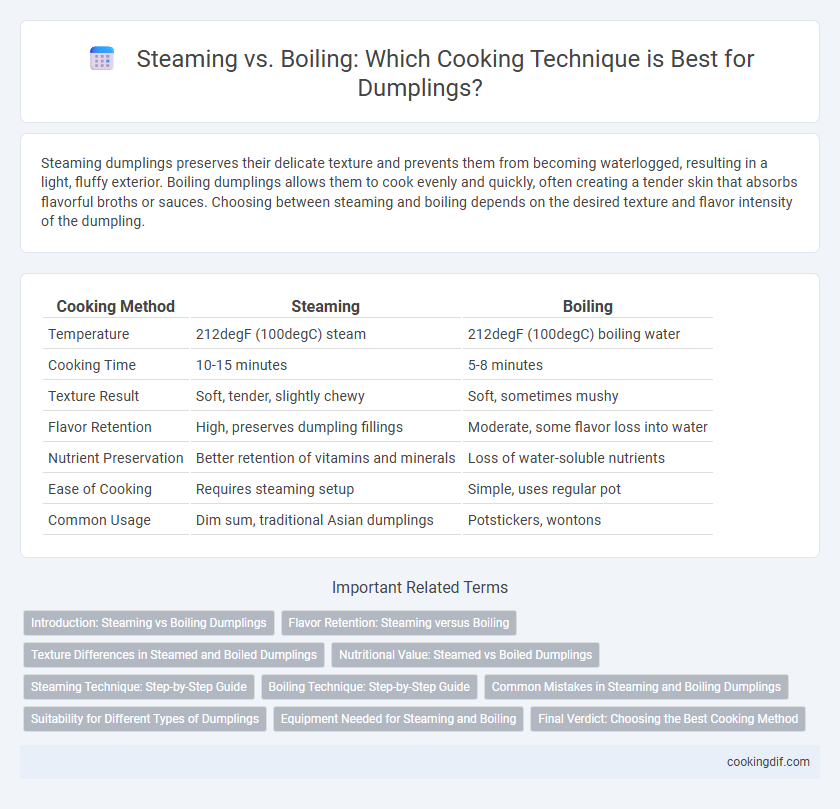Steaming dumplings preserves their delicate texture and prevents them from becoming waterlogged, resulting in a light, fluffy exterior. Boiling dumplings allows them to cook evenly and quickly, often creating a tender skin that absorbs flavorful broths or sauces. Choosing between steaming and boiling depends on the desired texture and flavor intensity of the dumpling.
Table of Comparison
| Cooking Method | Steaming | Boiling |
|---|---|---|
| Temperature | 212degF (100degC) steam | 212degF (100degC) boiling water |
| Cooking Time | 10-15 minutes | 5-8 minutes |
| Texture Result | Soft, tender, slightly chewy | Soft, sometimes mushy |
| Flavor Retention | High, preserves dumpling fillings | Moderate, some flavor loss into water |
| Nutrient Preservation | Better retention of vitamins and minerals | Loss of water-soluble nutrients |
| Ease of Cooking | Requires steaming setup | Simple, uses regular pot |
| Common Usage | Dim sum, traditional Asian dumplings | Potstickers, wontons |
Introduction: Steaming vs Boiling Dumplings
Steaming dumplings preserves their delicate texture and enhances flavor by cooking them evenly with moist heat, preventing sogginess. Boiling dumplings results in a softer outer layer and allows them to absorb water, which can change their taste and consistency. Choosing between steaming and boiling depends on desired texture and regional culinary traditions.
Flavor Retention: Steaming versus Boiling
Steaming dumplings preserves their delicate flavors by cooking them gently with moist heat, preventing dilution of the filling's taste, unlike boiling, where the dumplings are submerged in water causing some flavor to leach out. The steam maintains the dumpling's texture while locking in juices, enhancing overall taste intensity. Boiling can lead to a softer exterior and less pronounced filling flavors due to direct water exposure.
Texture Differences in Steamed and Boiled Dumplings
Steamed dumplings have a tender, slightly chewy texture with a moist exterior that retains the filling's juiciness, while boiling results in a softer, sometimes waterlogged skin that can be more delicate and slippery. The steaming process prevents the dumpling wrapper from absorbing excess water, preserving a chewy bite and distinct layers. In contrast, boiling allows water to penetrate the dough, producing a smoother, more uniform texture but less structural integrity.
Nutritional Value: Steamed vs Boiled Dumplings
Steaming dumplings preserves more water-soluble vitamins such as B vitamins and vitamin C compared to boiling, as nutrients are less likely to leach into the cooking water. Boiling dumplings can cause some loss of minerals and antioxidants due to direct contact with water and longer exposure to heat. Steamed dumplings maintain better nutrient density and retain a softer texture without nutrients being diluted.
Steaming Technique: Step-by-Step Guide
Steaming dumplings preserves their delicate texture and enhances flavor by cooking them evenly with moist heat. To steam dumplings, line a bamboo or metal steamer with parchment paper or cabbage leaves to prevent sticking, arrange the dumplings with space between them, and place the steamer over boiling water. Cover tightly and steam for 8-12 minutes, ensuring the water does not touch the dumplings and refilling water as needed to maintain consistent steam.
Boiling Technique: Step-by-Step Guide
Boiling dumplings involves submerging them in rapidly boiling water until they float, signaling they are nearly cooked; this process typically takes about 6-8 minutes depending on filling and size. Maintaining a gentle boil prevents dumplings from sticking together or tearing while allowing even cooking throughout. Draining the dumplings promptly and serving immediately preserves their tender texture and flavorful filling.
Common Mistakes in Steaming and Boiling Dumplings
Steaming dumplings often leads to soggy wrappers when too much water is used or the steamer basket is not properly lined, causing condensation to drip onto the dumplings. Boiling dumplings can result in bursting if the water is at a rapid boil or if dumplings are overcrowded, which prevents even cooking and causes sticking. Ensuring the correct water level, gentle steam circulation, and maintaining a gentle boil with adequate spacing can prevent these common cooking errors.
Suitability for Different Types of Dumplings
Steaming is ideal for delicate dumplings like har gow and xiao long bao, preserving their thin skin and juicy filling without waterlogging. Boiling suits robust dumplings such as pelmeni and potstickers, allowing a firmer texture and thorough cooking through immersed heat. Choosing the cooking method depends on dumpling dough thickness and desired texture, impacting flavor and mouthfeel.
Equipment Needed for Steaming and Boiling
Steaming dumplings requires a bamboo or metal steamer basket and a pot with a fitted lid to hold boiling water beneath the basket, allowing gentle, even cooking. Boiling dumplings needs a large pot filled with ample water to fully submerge the dumplings and a slotted spoon for removing them once cooked. Both methods demand heat-resistant tools but differ in equipment tailored to moisture control and cooking style.
Final Verdict: Choosing the Best Cooking Method
Steaming preserves the dumpling's delicate texture and enhances the flavor by preventing water absorption, resulting in a tender, juicy bite. Boiling cooks dumplings quickly and evenly but can lead to a slightly softer, less textured outer layer due to water saturation. For the best overall taste and mouthfeel, steaming is often preferred, especially for premium or handmade dumplings.
Steaming vs Boiling for cooking technique Infographic

 cookingdif.com
cookingdif.com